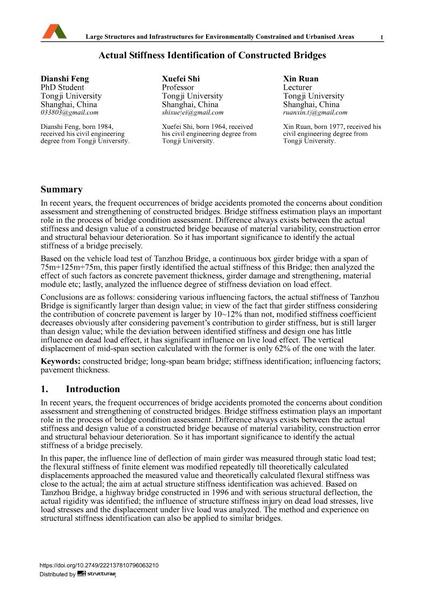Actual Stiffness Identification of Constructed Bridges

|
|
|||||||||||
Détails bibliographiques
| Auteur(s): |
Dianshi Feng
Xue-fei Shi Xin Ruan |
||||
|---|---|---|---|---|---|
| Médium: | papier de conférence | ||||
| Langue(s): | anglais | ||||
| Conférence: | IABSE Symposium: Large Structures and Infrastructures for Environmentally Constrained and Urbanised Areas, Venice, Italy, 22-24 September 2010 | ||||
| Publié dans: | IABSE Symposium Venice 2010 | ||||
|
|||||
| Page(s): | 652-653 | ||||
| Nombre total de pages (du PDF): | 6 | ||||
| Année: | 2010 | ||||
| DOI: | 10.2749/222137810796063210 | ||||
| Abstrait: |
In recent years, the frequent occurrences of bridge accidents promoted the concerns about condition assessment and strengthening of constructed bridges. Bridge stiffness estimation plays an important role in the process of bridge condition assessment. Difference always exists between the actual stiffness and design value of a constructed bridge because of material variability, construction error and structural behaviour deterioration. So it has important significance to identify the actual stiffness of a bridge precisely. Based on the vehicle load test of Tanzhou Bridge, a continuous box girder bridge with a span of 75m+125m+75m, this paper firstly identified the actual stiffness of this Bridge; then analyzed the effect of such factors as concrete pavement thickness, girder damage and strengthening, material module etc; lastly, analyzed the influence degree of stiffness deviation on load effect. Conclusions are as follows: considering various influencing factors, the actual stiffness of Tanzhou Bridge is significantly larger than design value; in view of the fact that girder stiffness considering the contribution of concrete pavement is larger by 10~12% than not, modified stiffness coefficient decreases obviously after considering pavement’s contribution to girder stiffness, but is still larger than design value; while the deviation between identified stiffness and design one has little influence on dead load effect, it has significant influence on live load effect. The vertical displacement of mid-span section calculated with the former is only 62% of the one with the later. |
||||
